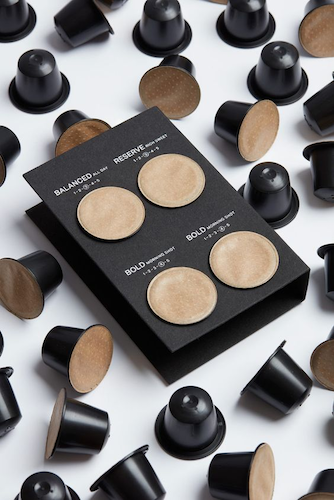As the world gets inevitably busy and critically advanced, alternative quick and easy methods have been discovered and developed for increased performance. Sometimes, people are so busy they can no longer afford to take a portion of their jam-packed schedule to make a cup of coffee.
Well, maybe that’s an exaggeration, but really, businessmen and manufacturers have cultivated a new way of brewing coffee that popularly surmounts the conventional practice – through a coffee capsule.

Source: BP&O
What is a coffee capsule? The coffee capsule is a type of single-serve coffees. And yes, it is different from coffee pods. Each respective machine cannot work for the other unless you go for a piece of equipment that brews both types. The coffee capsule is the general term for ground coffee packed and sealed inside a (plastic) cup, which is prepared through a coffee machine in a much quicker way.
The Making of Coffee Capsules

Source: Williams Sonoma
Normally, coffee capsules contain at least 5 to 8 grams of coffee. But of course, it’s not solely coffee. Manufacturers work gingerly and rigorously in giving the convenience that the consumers look out for without comprising the quality and taste of the coffee. They make sure the products are well-sealed, packaged, and labeled by selecting the best coffee capsule packaging machines.
From the fresh coffee beans – selected, roasted, ground – coffee producers choose their preferred kind of coffee grind. Though ordinarily, the medium grind or the so-called coarse grind is used. This affects the taste of the coffee. Anyway, here is the step-by-step process in manufacturing the coffee capsules we all have embraced and loved:
- Working on the Coffee Grind
Picking up on what was being discussed earlier, each brand has a signature type of coffee grind. To attain consistency, they will stick to it for the rest of the products they produce and distribute. Though, some companies sell all types of coffee grind.
Whatever the conditions may be, one thing is sacred: uniformity. The beans should be crushed or ground from its original state into a uniformly milled coffee. Whole beans cannot be blended with coarse grind or the coarse grind with the instant coffee grind. The texture, form, and grate must be even and consistent. The best inline homogenizers or batch homogenizers help immensely in achieving this step.
- Preparing the Cups and Packaging Machine
Generally, designed plastic cups – neat and clean, ready to store some coffee will be prepared next. The packaging machine will also be set up. The cups will be positioned on slots that will hold them while the filling of coffee and other procedure take place. Different colors of the cups signify the wide variants and types of coffee, including the flavors.
- Filling and Capping
After the preparatory stage, here comes the coffee loading phase. As mentioned a few paragraphs back, the coffee weight of one capsule spans from 5 to 8 grams, commonly. So, a ‘conveyor belt’ prompts the movement of cups settled in an assembly on the packaging machine. The movement indicates the turn of other cups to be filled, one after the other.
Some manufacturers include coffee filters in the capsules. Some don’t. Once the process is done, capping is up! Respective caps will be placed over the opened capsules with coffee to cover it. Again, one by one, as they all move systematically.
- Sealing
As simple as it may seem, we’re down to the fourth to the last step! Undeniably, this is the most important one – sealing. Sealing is complicated and crucial. If a product is not carefully and properly sealed, the consumers can use this against the manufacturer. In other cases, buyers ask for a replacement. If not provided, they can make a long tirade of bad review about the distributor or the producer itself.
The thing is, they only want to get what they pay for. We all do. That’s why sealing must receive an adequate amount of attention and careful work or companies will lose a huge amount of profit.
- The Brewing Test
But of course, hard work always pays off! With dedication, patience and good quality of processing, the right coffee capsule can be achieved. But it does not stop there, the finished products still need to be tested for quality purposes. Yes, the proper procedure was followed and monitored, but still, an assessment is necessary to ensure that the product requirements have been met.
These coffee capsules are set on appropriate brewing machines and are actually brewed. This way, they will be evaluated and checked if general defects are present. If yes, the entire batch of processed capsules might be pulled or impeded from entering the marketplace.
- Packaging and Arrangement
If the requirements are met and there are no classified defects during the inspection, the finished products proceed to the packaging stage. They are stored into boxes, arranged according to their flavors, types, and other categories. Then, labels are put onto them.
- Shipping and Distribution
Finally, we’re down to the last step! If things are all set and done, then the coffee capsules are good to go. Coffee shops, stores, merchandisers, and companies have been waiting for them, so they will be shipped and distributed to the rightful and loyal clients before reaching your convenience stores, groceries, and your coffee table.
Conclusion
Coffee capsules have been growing more popular and conventional today. Although some do not support it because of some cons, we believe that if you are a responsible coffee capsule user, their remnants will never harm the planet we live in. This applies not only for the coffee capsules and their plastic cups but for the rest of the products we excessively consume. If we don’t take any accountability for our waste, we will destroy our home.
